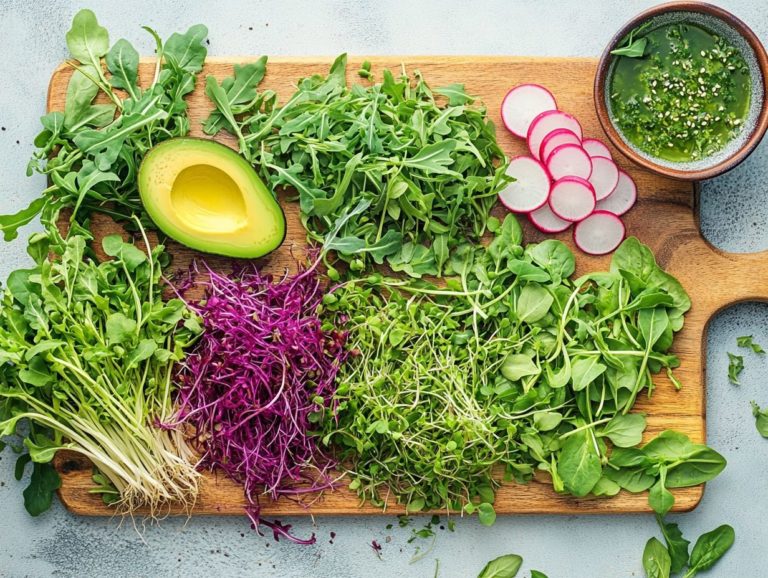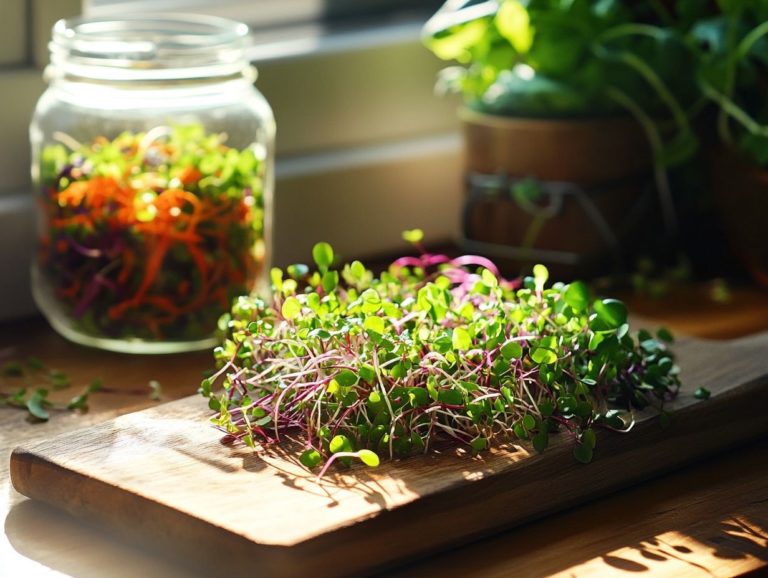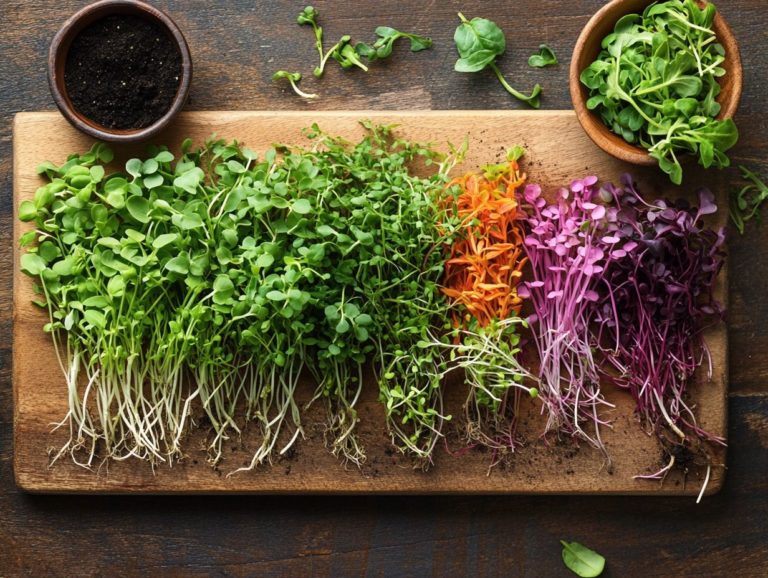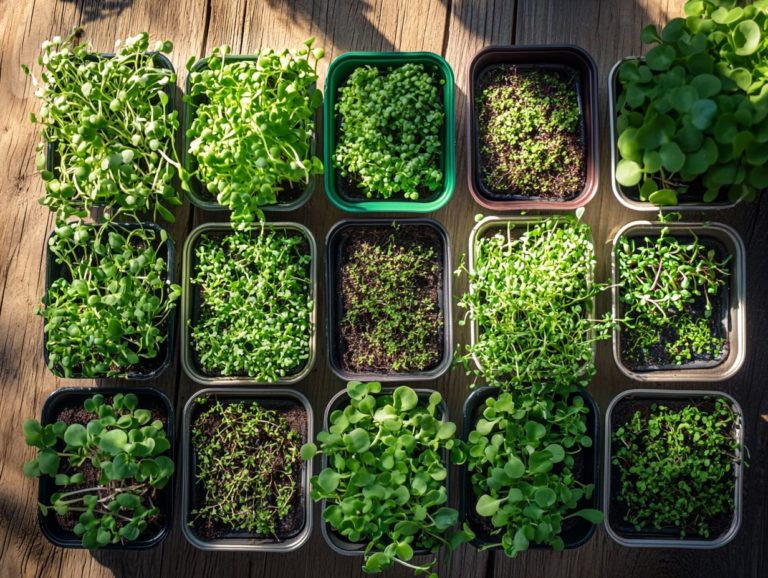Microgreens for Enhanced Nutrient Absorption
Microgreens have taken the culinary world by storm, captivating your senses with their vibrant colors and bold flavors while boasting an impressive nutritional profile.
These tiny greens are a powerhouse of essential vitamins and minerals, offering a simple yet effective way to elevate your diet effortlessly. Get ready to explore the amazing world of microgreens! This article examines what they are, how their nutrient content stacks up against mature plants, and the myriad health benefits they bring to your table.
You ll also uncover practical tips for incorporating them into your meals and learn how to grow them right at home. Are you ready to unlock the potential of these remarkable little greens? Let s dive in!
Contents
- Key Takeaways:
- What are Microgreens?
- Nutrient Content of Microgreens
- Benefits of Consuming Microgreens
- How to Incorporate Microgreens into Your Diet
- Growing Your Own Microgreens
- Potential Risks and Precautions
- Frequently Asked Questions
- Curious about microgreens? Here’s what you need to know!
- 1. What are microgreens and how can they enhance nutrient absorption?
- 2. How do microgreens differ from sprouts in terms of nutrient absorption?
- 3. Which types of microgreens are best for enhanced nutrient absorption?
- 4. How can incorporating microgreens into my diet improve my overall health?
- 5. Are there specific ways to consume microgreens for better nutrient absorption?
- 6. Can anyone benefit from adding microgreens to their diet, especially those managing conditions like Alzheimer s disease?
Key Takeaways:

- Microgreens are young, edible plants that are harvested at an early stage of growth.
- These small but mighty greens contain higher nutrient levels compared to their mature counterparts.
- Consuming microgreens can improve your body’s absorption of essential vitamins and minerals, along with other potential health benefits.
What are Microgreens?
Microgreens are delightful young edible plants you can harvest just after the first leaves have emerged, usually within 7 to 21 days post-germination. They belong to a stunning variety of plant families, such as Brassicaceae, Asteraceae, and Apiaceae. Often affectionately dubbed baby greens or vegetable confetti, they boast vibrant colors and textures.
These nutrient-dense greens offer an impressive range of flavors and aromatic notes that can elevate your culinary creations, whether you’re cooking at home or impressing guests at a fine dining establishment.
Definition and Types
Microgreens are essentially young seedlings of edible vegetables, herbs, or other plants, packed with concentrated nutrients. You can categorize them into various types, including micro herbs and baby greens.
Among the many varieties of microgreens, some truly shine with their distinct flavors and growing conditions. For instance, arugula brings a delightful peppery kick to your dishes, while basil is celebrated for its sweet and aromatic profile. These diminutive greens flourish in a variety of environments, from well-draining soil to hydroponic systems, making them a fantastic option for both home gardeners and professional chefs. Incorporating these greens into your meals highlights the role of microgreens in healthy eating.
Incorporating these tiny greens into your culinary creations enhances the visual appeal and elevates the taste experience. Imagine a burst of flavor that beautifully complements salads, sandwiches, and garnishes; it’s a game changer in the kitchen, especially when you consider unlocking the antioxidant power of microgreens.
Nutrient Content of Microgreens
The nutrient content of microgreens is truly impressive, often surpassing that of their mature counterparts. Many varieties are packed with concentrated nutrients, polyphenols (compounds that may help reduce inflammation), and antioxidants (substances that can help fight cell damage) elements that can significantly enhance your overall health.
Comparison to Mature Plants
Microgreens often boast dramatically higher nutrient levels, providing concentrated nutrients essential for a balanced diet. Harvested in their early growth stage, these tiny greens deliver substantial amounts of vitamins, minerals, and antioxidants that can be more potent than their fully developed counterparts.
A study published in the Journal of Agricultural and Food Chemistry revealed that varieties like radish, broccoli, and kale microgreens can contain up to 40 times more nutrients than mature vegetables. Their impressive levels of vitamins C, E, and K play a significant role in boosting immune function and promoting skin health, contributing to your overall well-being. For more insights, check out the health benefits of microgreens explained.
The unique flavors and vibrant colors of microgreens enhance your dishes, encouraging a varied diet that supports health. As you seek out nutrient-dense options, incorporating these miniature powerhouses into your meals can elevate both your nutritional intake and culinary enjoyment.
So why not take the plunge? Try growing your own microgreens or experiment with incorporating them into your meals to experience their incredible benefits!
Benefits of Consuming Microgreens

Consuming microgreens offers a wealth of health benefits. These tiny powerhouses enhance nutrient absorption and are packed with beneficial compounds.
They can assist in combating serious issues such as heart disease, Alzheimer s, and diabetes, playing a significant role in fighting malnutrition.
Enhanced Nutrient Absorption
Microgreens have a remarkable ability to enhance nutrient absorption. Packed with concentrated nutrients, these tiny greens support your digestive health.
Research shows that microgreens are abundant in vitamins, minerals, and phytonutrients that can significantly boost gut health. High levels of antioxidants found in microgreens may help cultivate a healthier microbiome, encouraging the growth of beneficial bacteria crucial for digestion. Additionally, exploring ways to enhance flavor in microgreens can further elevate their nutritional benefits.
These young greens are rich in dietary fibers and enzymes that assist in breaking down food and improve how well your body absorbs nutrients. Adding the best microgreens for nutritional value to your diet can optimize your digestive efficiency and overall nutrient uptake.
Other Health Benefits
Microgreens do more than enhance nutrient absorption. They also present compelling health benefits, including the potential to lower the risks associated with heart disease, Alzheimer s, and diabetes thanks to their rich antioxidant content.
These tiny powerhouses are loaded with essential vitamins, minerals, and phytochemicals that help your immune system stay strong, promote better digestion, and may even enhance your skin health. Antioxidants found in microgreens, like vitamins C and E, can help counteract oxidative stress, a key player in various chronic conditions. For health enthusiasts, exploring the top microgreen varieties can provide additional benefits.
By weaving these vibrant greens into your daily meals, you can elevate your body’s natural defense mechanisms and foster overall wellness. They can also help improve joint health and assist in weight management, making them a valuable addition to your balanced diet, especially considering the benefits of eating microgreens daily.
How to Incorporate Microgreens into Your Diet
Incorporating microgreens into your meals is a delightful opportunity to elevate both the flavor and nutritional value. These vibrant greens integrate seamlessly into various culinary applications and provide unique recipes that tantalize your palate.
Recipes and Meal Ideas
Imagine adding microgreens to your salads, sandwiches, and soups, or using them as elegant garnishes for sophisticated dishes worthy of high-end restaurants!
These petite greens deliver a burst of flavor that can elevate even the simplest recipes into something truly gourmet. Picture a vibrant salad adorned with radish microgreens that complement citrus segments with a delightful peppery kick or how basil microgreens can amplify the aroma and flavor of a classic Caprese sandwich. Discover why microgreens are superfoods you need to add to your meals.
Don’t overlook the joy of adding sunflower microgreens to a warming bowl of butternut squash soup, providing a delightful crunch and a nutritional boost. For those looking to enhance their meals, exploring the top 10 microgreens for nutritional boost showcases the incredible versatility of microgreens and invites both home cooks and seasoned chefs to embrace their creativity!
Growing Your Own Microgreens
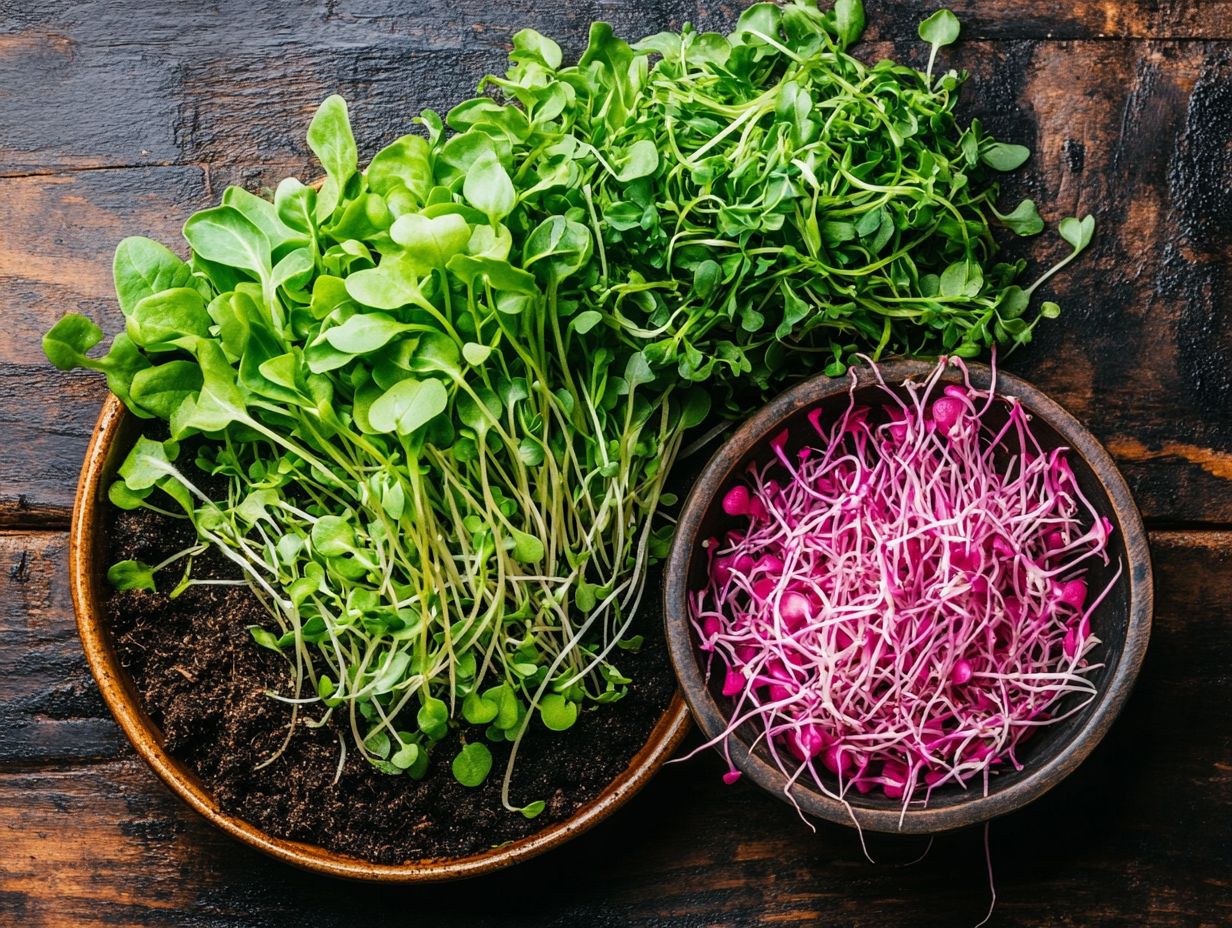
Growing your own microgreens is a gratifying endeavor and a practical method to ensure you have a steady supply of fresh, nutrient-rich greens at your fingertips.
With a clear, step-by-step guide, you can effortlessly navigate the diverse growing conditions and techniques that will lead you to optimal results.
Start growing your own microgreens today for fresh, flavorful meals!
Tips and Techniques for Home Growing
Are you ready to embark on an exciting journey of growing your own microgreens? With just a few tips and techniques, you can enjoy a bountiful and tasty harvest.
First and foremost, choosing the right soil is essential. A well-draining, nutrient-rich medium will foster healthy growth. Pay attention to your watering routine; overwatering can lead to root rot, while underwatering can stunt development. Finding that perfect balance is crucial.
Light exposure is another key player. Microgreens thrive under bright, indirect light for about 12 to 16 hours a day.
Proper harvesting methods, such as cutting just above the soil line with clean scissors, will ensure your microgreens flourish and retain their great taste and nutritional value.
Potential Risks and Precautions
While microgreens can provide a wealth of health benefits, it’s crucial to be aware of potential risks like food poisoning and allergic reactions. Taking essential precautions will ensure both safe consumption and successful cultivation.
Food Safety and Allergies
Food safety is crucial when enjoying microgreens. Improper cultivation or handling can lead to food poisoning, and certain individuals may be allergic to specific varieties, including those from the cabbage family, such as broccoli and kale. This concern is particularly heightened since microgreens are often consumed raw, which increases the risk of contamination.
To mitigate these risks, it’s vital to adhere to strict hygiene practices throughout the growing process. Thoroughly wash your hands and ensure that all equipment and surfaces are impeccably clean. Furthermore, being aware of common allergens present in microgreens, like those found in mustard or sunflower varieties, adds another layer of responsibility for you as a grower. Incorporating microgreens: the secret to healthy skin can also enhance the overall health benefits of your growing efforts.
Utilizing sealed containers during storage and clearly labeling your produce can significantly assist consumers in identifying potential allergens, enhancing their safety as they incorporate these nutritious greens into their diets.
Frequently Asked Questions
Curious about microgreens? Here’s what you need to know!
1. What are microgreens and how can they enhance nutrient absorption?
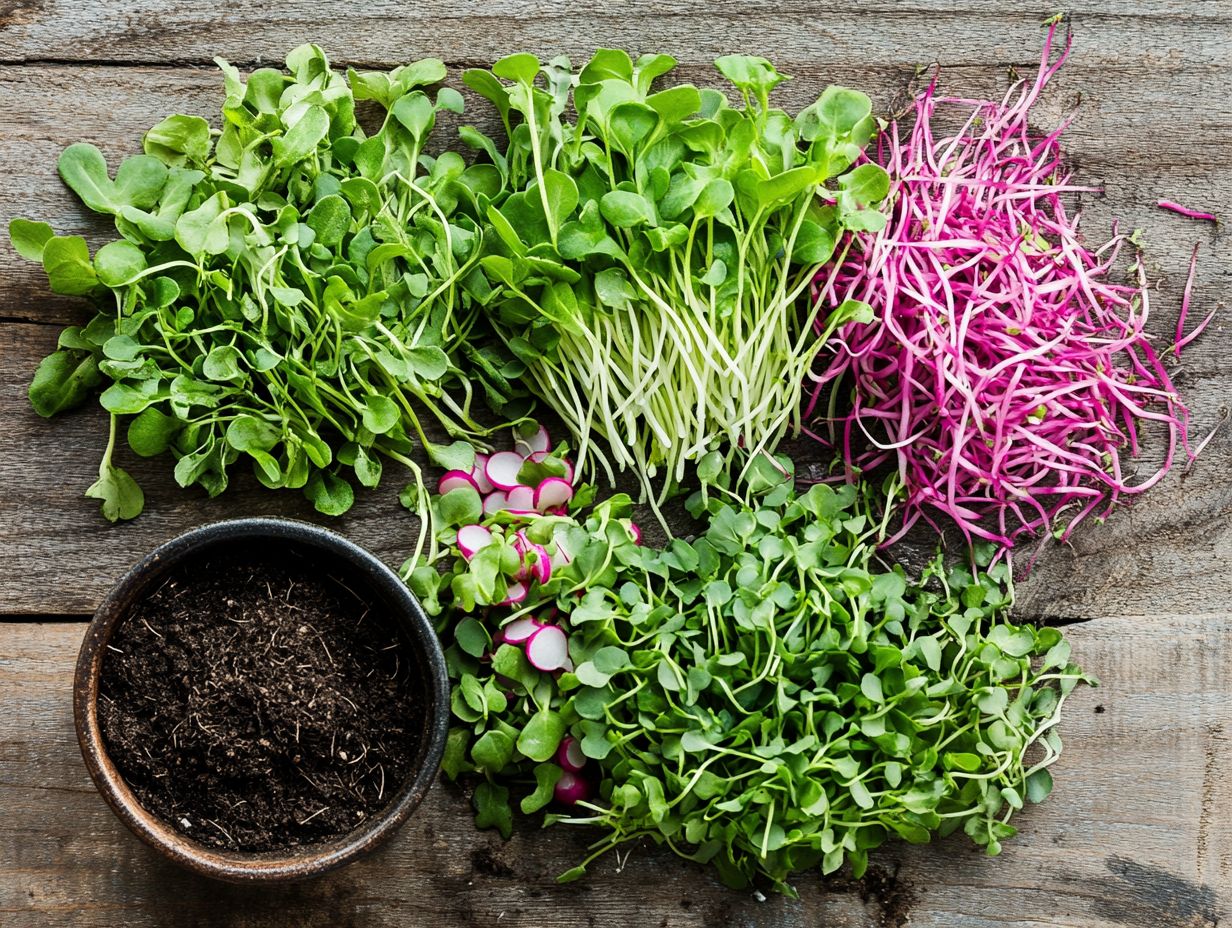
Microgreens are young vegetable greens harvested at the first true leaf stage. These greens are known to have higher concentrations of nutrients compared to their mature counterparts, making them an excellent source for enhancing nutrient absorption in the body.
2. How do microgreens differ from sprouts in terms of nutrient absorption?
Microgreens are typically grown in soil and allowed to develop their first true leaves, while sprouts are germinated seeds that are typically consumed at an earlier stage. Microgreens have been found to contain significantly higher levels of nutrients, making them a better choice for enhancing nutrient absorption in the body.
3. Which types of microgreens are best for enhanced nutrient absorption?
Different types of microgreens offer varying levels of nutrients. Some of the best microgreens for enhanced nutrient absorption include broccoli, kale, radish, and red cabbage.
4. How can incorporating microgreens into my diet improve my overall health?
By adding microgreens to your meals, you increase your intake of essential vitamins, minerals, and antioxidants. These nutrients are known to boost immunity, improve digestion, and support overall health and well-being.
5. Are there specific ways to consume microgreens for better nutrient absorption?
Yes, you can enjoy microgreens in many ways! Add them to salads, sandwiches, smoothies, or use them as a garnish for soups.
Eating them raw or lightly cooked helps retain their nutritional value.
6. Can anyone benefit from adding microgreens to their diet, especially those managing conditions like Alzheimer s disease?
Absolutely! Microgreens can enhance anyone’s nutrient intake and overall health.
They are also perfect for those with dietary restrictions, like vegans and vegetarians, as they offer a variety of nutrients, including iron and protein.

